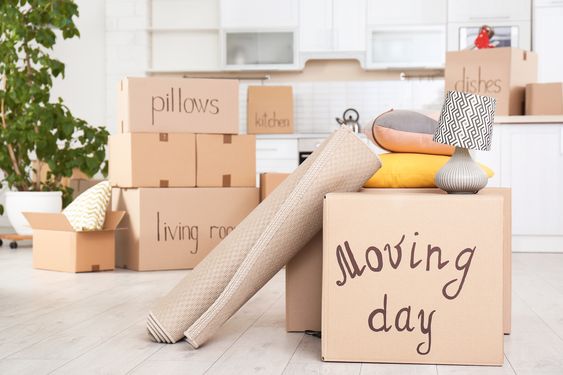Are you moving – here are some tips to smooth out the packing process?
Thank you for reading this post, don't forget to the best blogger Guy About Home who offers the best garden and home improvement tips! If you are a home decor and design fan, don't miss the tips on home ideas. If you are a home garden owner, then you might be interest in our complete guides to house plants!
Prior to Packing
The process of packing is very important, which is why you need to create a plan before starting. Planning comes at the top of a moving house checklist and will ensure that you get through the move in an organized fashion.
Plan exactly how each room will be packed. Start at the top of the house moving downwards. In case you have a loft, you should consider sorting it out first. Label each box with the room to which it belongs.
Identify the packing materials you will need. Estimate the number of boxes that you will likely need and ensure that you get them well in advance. Find boxes in several different sizes and think about other items you require such as bubble wrap and tape. Invest in hiring a professional moving company so that the experts can transport your belongings safely and efficiently.
Take time to sift through all your belongings and have a clear-out. You can make up a box for charity donations.
Packing Hacks
Everybody appreciates time and money saving tips. Here are some of the most useful packing tips when moving house.
Labeling
Empty all of your appliances and pack up the accessories, such as the wires, separately. Ensure that you take note of which wire belongs to which accessory. To do this, coil the wire, put masking tape around it, and then note down the appliance it belongs to on the tape.
Important Items
Pack important documents such as marriage and birth certificates together, and keep them in a safe place. Ideally, you should carry all important information and passports in the ‘essentials’ box or on your person during the trip. Misplacing a passport is a far greater tragedy than losing a lamp.
Essentials
Pack a clear plastic box with things that are needed right away. Items such as a phone charger and toothbrush are essential items you will need to use on the first day in your new home, so make sure that they are easy to find.
Packing Heavy Items
Pack books and other heavy objects in small boxes and avoid making the box too heavy, especially if you are using cardboard boxes. Heavier boxes should be put on the bottom. Packing tips like this one might be common sense, but are still worth mentioning.
If you put the heavy boxes below the lighter ones, you will ensure that none of your breakable items will be crushed during the move. It can also be a good idea to label which boxes are particularly heavy or light, the former is very important for avoiding injury.
Packing Cables
Used toilet roll tubes are handy holders for cables and you can easily write on them to identify your iPhone cable from the rest of your cables.
Packing Makeup and Toiletries
Use cling film to cover any openings of your toiletries, then put the tops back to ensure that they don’t leak. Place an additional cotton ball or pad into your powder cosmetics to ensure that they don’t crack.
Packing Textiles and Clothes
Slide clothes on hangers into rubbish bags directly and use string to tie the hangers together for easy transportation of clothes. Put a hole in the bottom of the rubbish bag, pull the hangers through it and tie a knot on the bottom. It is a far better approach than folding your clothes and putting them into boxes.
To protect rugs and carpets, roll them up and use rope to secure them and then put a bag or cover over each end to keep them clean.
Packing Fragile Items
Stack up pots and pans and then wrap them in paper/newspaper. Don’t stack the dishes, however, so that they remain flat. Each of your dishes should be wrapped individually and then packed vertically just like vinyl records.
If you stack dishes on top of each other, you risk putting a lot of pressure on the bottom plate and this is more likely to cause breakages. Smaller items, such as spice pots should be stored inside of large pots and bowls.
Protect your mirrors and artwork by wrapping them in paper first and then packing them in mirror boxes. When it comes to the larger pieces, you should securely tape cardboard over them. Create an X shape on your mirrors using packing tape to ensure that they don’t crack.
Packing Large Items and Moving Electronics/Appliances
Furniture
If you’re disassembling any large pieces of furniture, such as a cupboard or bed, label the parts and ensure that all parts are packed together. Put all smaller fittings and screws in a labeled bag and tie/tape it to the larger parts. Cover the arms and legs of your chairs using bubble-wrap.
Computers
The first thing you should do before packing any computer is to backup your data. You can use a USB thumb drive, external hard driver, or the Cloud for this. Turn your computer and all the attached devices off and unplug them from the mains, and unplug any peripherals.
Label each of the cables clearly so that you know where each one needs to be reconnected. If you don’t have the original packaging, you will require a thick-walled box, bubble wrap in plenty, packing paper, or any other cushioning material that can be used to surround your computer.
Bikes etc
Packing ebikes should ideally be done with bubble wrap and a box if you can find one. The best option is the original box the item came with if you still have it.
Fridge Freezers
Ensure that you leave enough time to defrost and drain your freezer and refrigerator. A few hours should usually be sufficient.
Gas Ovens
A Gas Safe registered gas engineer is the only one who can disconnect a gas oven. Best to do this at least several days if not weeks before the move. Ideally, you should book in advance so that you aren’t forced to find someone to do this at the very last minute.
Washing Machines
Unplumbing a washing machine isn’t difficult, but only if you know exactly what you are doing.




